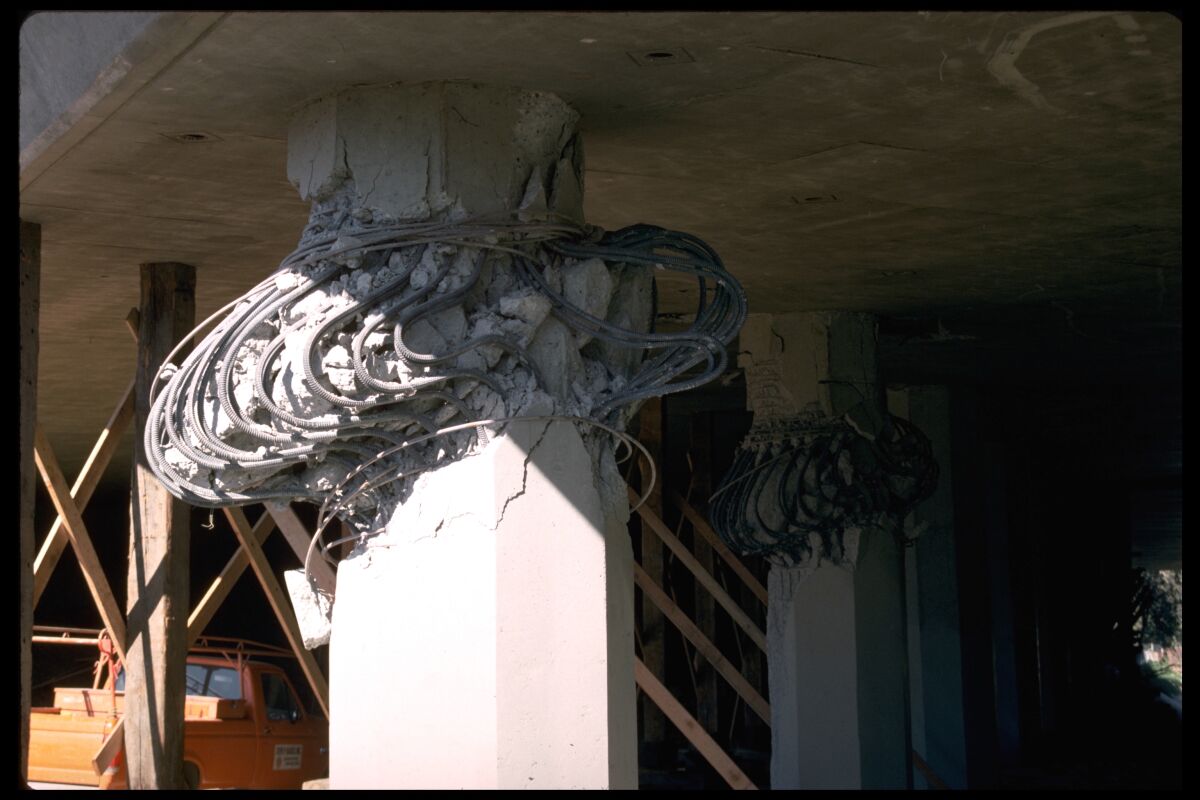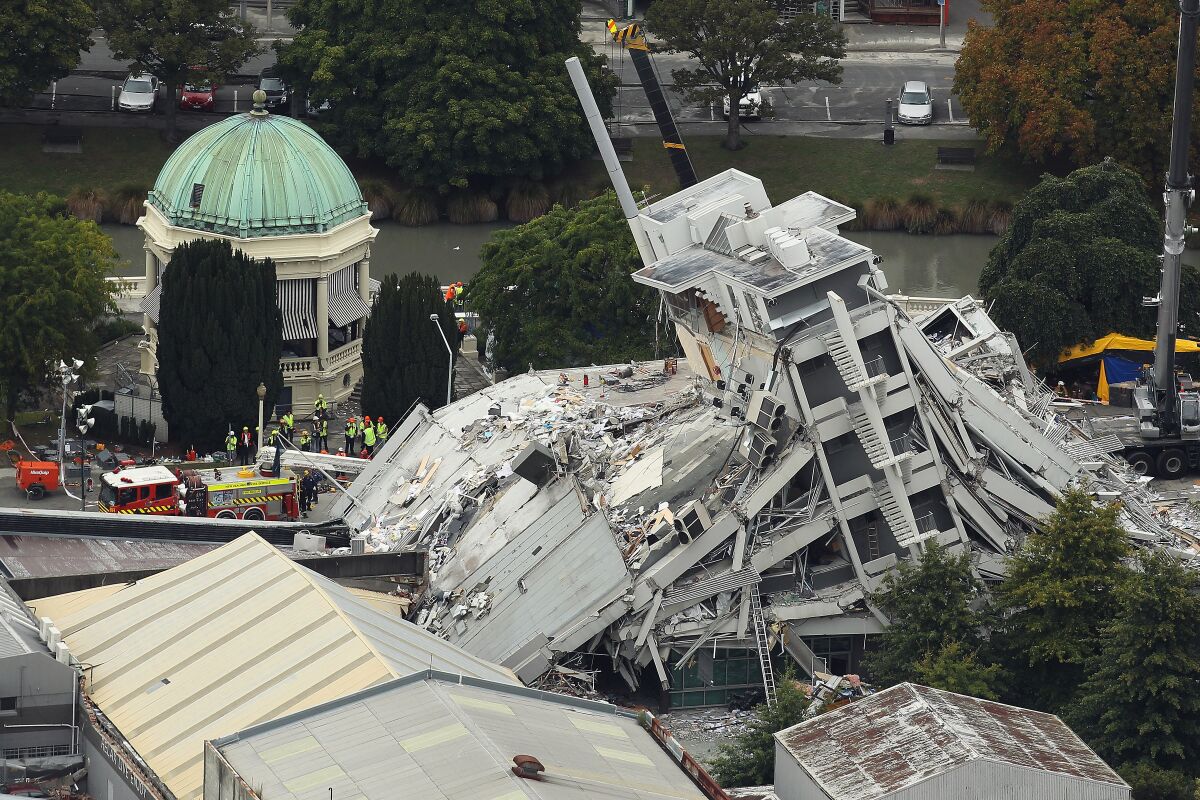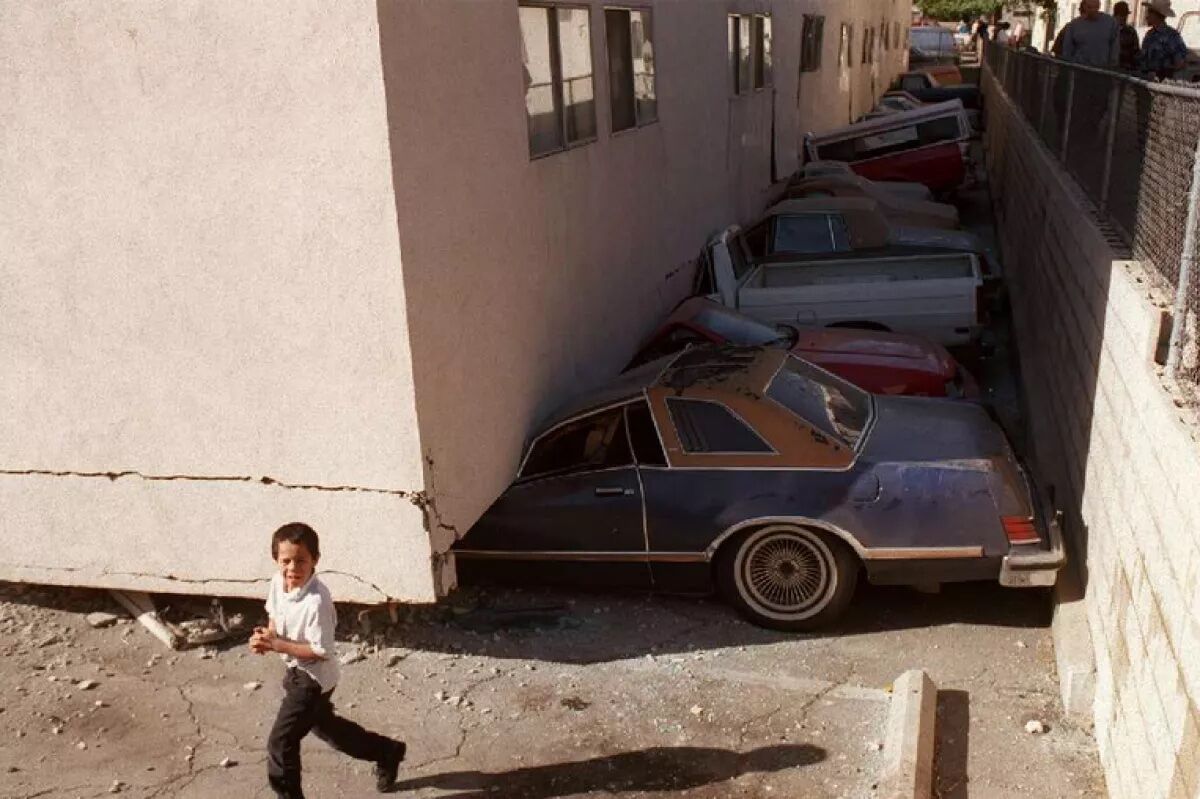Los Angeles County took the first step Tuesday toward a mandatory earthquake retrofit order for the types of concrete buildings that collapsed catastrophically in the devastating earthquakes that shook Turkey and Syria, causing many of the 50,000 deaths tallied so far.
The Board of Supervisors voted unanimously to ask officials to prepare new rules that would require “non-ductile” concrete buildings owned by the county, as well as any located in unincorporated areas, to be retrofitted. Once the new rules go into effect, building owners would have 10 years to complete the retrofits.
The supervisors also ordered officials to create an inventory in unincorporated areas of all “soft-story” residential buildings — structures vulnerable to come tumbling down in the next big earthquake.
“By taking inventory, we will have a true understanding of the scale of how many buildings and people that could be impacted by a major earthquake,” said Supervisor Holly Mitchell, who co-authored the motion with Supervisor Hilda Solis. “This will allow us to proactively plan and save lives for when — not if — major seismic activity occurs.”
The older type of concrete buildings targeted by officials have a well-known defect discovered in the 1971 Sylmar earthquake.
The deficiency involves an inadequate configuration of steel reinforcing bars in the concrete frames of buildings — many of which were built in the post-World War II building boom across California and around the world. The flaw of insufficient steel reinforcement in the concrete frame allows concrete to explode out of columns when shaken in an earthquake, a prelude to a catastrophic collapse.

After shaken by the 1994 Northridge earthquake, concrete in this column explodes outward, coming closer to failure. Concrete frames built before the 1980s can have a defect in which the configuration of steel reinforcing bars within the concrete is inadequate, and cause collapses in an earthquake.
(U.S. Geological Survey)
Following the 1971 earthquake, the buildings were declared to be non-ductile, meaning they’re brittle and prone to collapse in an earthquake. That type of construction was deemed so unsafe that it was banned for future construction by the 1980s. But most local governments have done little to order older buildings be evaluated and strengthened if found to be deficient.
A number of these non-ductile concrete buildings collapsed in the 1971 Sylmar and 1994 Northridge earthquakes, which were magnitude 6.6 and 6.7, respectively.
Forty-nine people died in the collapse of the Veterans Administration hospital in Sylmar, and three were killed when the newly built Olive View Medical Center saw buildings and stairways collapse, lurch or topple. A Kaiser Permanente office and clinic and a Bullock’s department store partly collapsed in the 1994 Northridge earthquake.

San Fernando Veterans Administration hospital patients wait for evacuation to other facilities as the ruins of collapsed buildings are searched for victims after a magnitude 6.6 earthquake hit near Sylmar on Feb. 9, 1971. The hospital was a non-ductile concrete building.
(Bruce Cox / Los Angeles Times)
The same type of non-ductile flaw led to the collapse of freeways in the Northridge earthquake and the 1989 Loma Prieta quake in the San Francisco Bay Area.
A magnitude 7.8 earthquake, producing the same energy that came out of the most powerful quake in Turkey, would be so much more destructive in Southern California simply because a much wider region would suffer severe shaking — covering a land area dramatically larger than in any earthquake California has encountered in more than a century.
The only two magnitude 7.8 earthquakes since California became a state both occurred on the San Andreas fault. The one that hit Northern California in 1906 destroyed much of San Francisco. And the one that hit Southern California in 1857 ruptured about 186 miles of the San Andreas fault from Monterey County to Los Angeles County, sending shaking so powerful that it uprooted and sank trees, and produced strong shaking that lasted up to three minutes.
The strongest shaking from the 1857 earthquake hit a huge swath of Central and Southern California, according to U.S. Geological Survey estimates. By contrast, the strongest shaking in the 1994 Northridge earthquake was generally limited to the San Fernando Valley.
“While there are only a handful of non-ductile concrete buildings in unincorporated areas or owned by the county, the county must insist on renewed urgency to retrofit and repair vulnerable structures to prevent as much loss of life as possible in the event of major seismic activity,” the county motion said. “The county should follow the example of surrounding jurisdictions, which have enacted aggressive timelines to require seismic retrofits of the most vulnerable buildings.”
A U.S. Geological Survey simulation said it is plausible a magnitude 7.8 earthquake in Southern California could cause 50 non-ductile concrete buildings to fully or partly collapse, with as many as 7,500 people in them. The U.S. Geological Survey has called non-ductile concrete buildings among those that “pose the greatest risk to life safety.”
David Cocke, president of the Earthquake Engineering Research Institute and a structural engineer with Gardena-based Structural Focus, praised efforts to get more non-ductile concrete buildings retrofitted.
He said the action that the city of Los Angeles took in 2015 to order non-ductile concrete buildings be retrofitted by the 2040s has resulted in “dozens and dozens of pretty sizable projects that are in plan-check, in design and even in construction.”
“There’s a lot of deficient older concrete buildings, everywhere all over the world, as well as in California,” Cocke said. “We definitely need to address them.”
The collapse of even a single large concrete building can not only take many lives, but devastate an entire city’s economic core for a generation or more, paralyzing efforts to rebuild once the shaking fades.
Non-ductile concrete buildings have been responsible for the deaths of many people in major earthquakes over decades. Yet apart from the city of Los Angeles and a couple of other smaller California cities, few governments worldwide have summoned the political will to tackle the problem.
The collapse of two non-ductile concrete buildings in Christchurch, New Zealand, after a 2011 earthquake caused the vast majority of deaths in that earthquake. Of the 185 people who died, 115 died from the collapse of the CTV building, and 18 from the collapse of the Pyne Gould Corp. building — both non-ductile concrete buildings.

Eighteen people died in the collapse of the Pyne Gould Corp. building during an earthquake in Christchurch, New Zealand in 2011. It was a non-ductile concrete building.
(Hannah Johnston / Getty Images)
Structural engineers viewing extensive damage from collapsed buildings in Mexico City during a 2017 earthquake said that they were also of a non-ductile concrete construction. Corruption and inadequate attention to existing building regulations also played a role, an investigation by a nonprofit found.
County supervisors also ordered officials to create an inventory of all so-called soft-story residential buildings in unincorporated areas as well as those owned by the county. Such soft-story apartment buildings are killers as well — the building that triggered the single-largest loss of life in the 1994 earthquake came with the collapse of the Northridge Meadows apartment complex, where 16 people died.
The motion stopped short of calling for a mandatory retrofit program for soft-story apartments. But other local governments in the past have sometimes ordered an inventory first as a prelude to a mandatory retrofit order.
Supervisors warned that failing to act on vulnerable soft-story apartments could result in disproportionate death toll in Black and Latino areas.
Soft-story apartments, also known as dingbats, have flimsy poles on the ground floor that prop up carports and can snap in an earthquake. County leaders say these soft-story structures are more likely to be located in low-income communities.

Crushed vehicles at a soft-story apartment building that collapsed during the 1994 Northridge earthquake.
(Roland Otero / Los Angeles Times)
“It is no secret that older buildings tend to be concentrated in low-income communities of color,” Solis said. “To that end, we must meet the moment through equitable preparedness.”
The supervisors also asked county officials to identify programs to support property owners with the cost of seismic retrofits, including a zero-interest loan program and subsidies for low-income homeowners.
Max Sherman, a lobbyist with the Apartment Assn. of Greater Los Angeles, asked the board to limit its actions to just non-ductile concrete buildings and any buildings the county owns, but not privately owned soft-story apartments. He said creating an inventory of potentially vulnerable soft-story apartments would likely cause apartment owners to see insurance premiums dramatically increase.
Sherman said the upgrades to soft-story apartments would be too costly for landlords who were still reeling from months of missed rent from the eviction moratorium and a rent freeze during the pandemic. He said their members were “barely surviving” and warned of “catastrophic financial strain” if the board moved forward.
“While seismic retrofitting serves a vital need, it is important to recognize that these projects are extremely costly,” he said. “We ask the county to not start this process with housing providers still reeling from financial hardships.”

Soft story apartments can collapse because the skinny poles holding up the carports can snap when shaken.
(Raoul Rañoa / Los Angeles Times)
Matthew Buck with the California Apartment Assn., which represents rental property owners across the state, urged county leaders Tuesday to solicit feedback from owners about retrofit timelines.
Buck noted that the city of Los Angeles gave owners 25 years to complete a retrofit for non-ductile concrete buildings, while the county has proposed a 10-year deadline.
“Our members definitely understand the importance of safety,” Buck said. “Real consideration needs to be given to the cost for retrofitting.”
Santa Monica has an estimated 70 non-ductile concrete buildings, and gave owners a 10-year deadline to retrofit, which ends in 2027.
West Hollywood has tallied an estimated 27 non-ductile concrete buildings, and an additional 40 buildings that have either a concrete or steel frame. West Hollywood gave a 20-year deadline to get concrete buildings retrofitted once an owner has been notified by the city, although deadlines have been extended due to the pandemic.
A Times investigation published in 2013 detailed how the city of Los Angeles knew about the deadly flaw of non-ductile concrete buildings for decades, yet did little to address it. Following that report, then-Mayor Eric Garcetti brought on seismologist Lucy Jones as a science adviser to help confront L.A.’s risks in a massive earthquake, meeting scores of times with property owners, businesses and other groups.
The result of that yearlong process led to Garcetti proposing, and the City Council approving, a landmark law requiring that property owners in Los Angeles retrofit non-ductile concrete and soft-story buildings.
There are more than 1,300 non-ductile concrete buildings currently identified by the city of Los Angeles, and nearly 13,000 soft-story buildings within city limits. More progress has been made on the soft-story buildings, with more than 8,000 already retrofitted.
After Los Angeles city officials acted, Santa Monica and West Hollywood enacted laws that order retrofitting of non-ductile concrete and soft-story buildings. While a number of California cities have ordered soft-story buildings to be retrofitted, many have not, and only L.A., Santa Monica and West Hollywood have issued orders for non-ductile concrete buildings.
Other cities in California that have retrofit orders in place for soft-story buildings include Culver City, Beverly Hills and Pasadena. In Northern California, San Francisco, Berkeley, Oakland and Fremont have such laws on the books as well.


